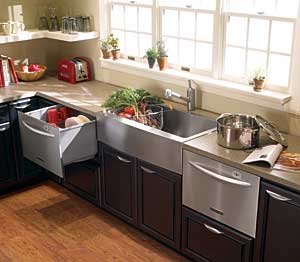Universal Design Solutions: Integrating Innovative Products and Spatial Design
Provide Options for All People
The idea for universal design in housing grew out of the recognition that, because most of the features needed by people with disability are useful to others, there is justification to make their inclusion common practice. Examples include: raising electrical receptacles to 15 inches or 18 inches above the floor eliminates the need to bend over as far and makes it easier for everyone. Mobility is much easier in houses with stepless entrances and wider door and hallways.
Some universal design features create experiences many people have not had before. For example, when well-designed bathrooms with extra floor space to accommodate users of mobility aids are perceived as luxurious, and people revel in their now-found ability to have furniture in the bathroom. A chair, bookcase, towel rack, or é´¡gè²¥ can give bathrooms a marketable elegance and utility and can be removed if the space is ever needed to accommodate a disabled family member of friend.
 |
| Drawer dishwashers are a good option for universal design by mounting the unit higher in a pull-out configuration. |
In housing, homeowners and builders began to recognize the universal design features that would support them into the future without taking away from the home's appearance, some of which we mentioned above:
- Wide doors
- Stacked closets that can be converted into an elevator
- Kitchen with many easy-to-reach amenities, such as undercounter dishwashers and refrigerator drawers
- Main floor bedroom suite
Incorporating universal design into the kitchen includes not only the location of appliances but their ease of operation as well. A simple change in the design of an appliance can make a big different in accessibility. For example, a wall oven that opens on the side instead of the top makes it easier for a person in a wheelchair to reach inside the oven. Appliance manufacturers are rethinking everything from the size of knobs to the shape of a door handle in order to make appliances more user-friendly. Appliance manufacturers are combining a sense research-based ergonomics with ease-of-use features, to create products that are convenient for everyone.
For increased visibility, some of the new features include:
- Larger-print labels on appliances
- Large-print owner's manuals
- Light-colored ranges with contrasting dark cast-iron elements to help those with limited vision
- Dryers with audible lint chime when it's time to clean the filter
- Side-swing doors on wall ovens and microwaves that provide easier and safer access
- Refrigerators that allow people in wheelchairs or individuals under five feet easier access to both frozen and refrigerated food
- Adjustable slide-out refrigerator shelving that can be set at more convenient heights
It's important to note that advocates maintain that universal design is a set of principles, not a standard or code, and that it goes far beyond the minimum specifications and limitations of legislated mandates for accessible and barrier-free facilities. Think of it this way. Codes and standards tell you what you must you. Universal design concepts open up the world of opportunity to what you can do.









